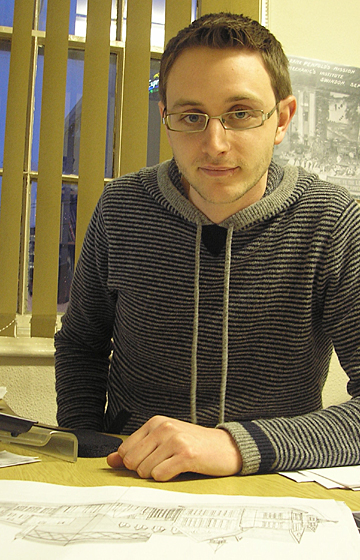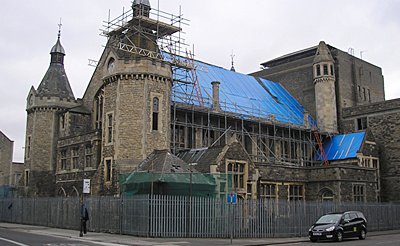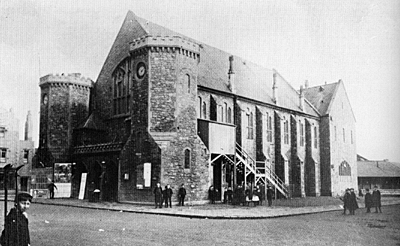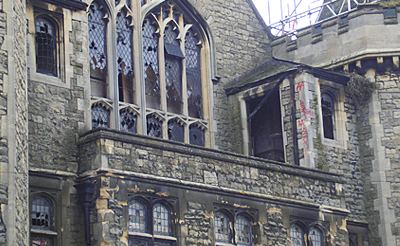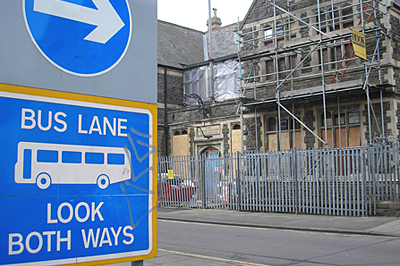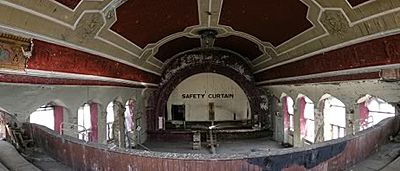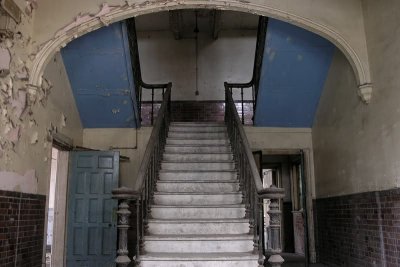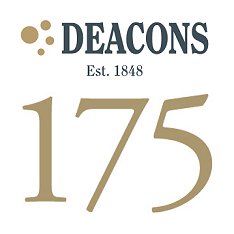Back to the future at the Mechanics'
What next for arguably Swindon's most important building?
March 2010: as arguments over the fate of Swindon's historic Mechanics' Institute hit the headlines again, we talk to Daniel Rose, chairman of the New Mechanics' Preservation Trust Limited, about their plans for the building - and dispel some of the myths surrounding it.
They say first impressions are everything, and when you first meet Daniel Rose, chairman of the New Mechanics’ Preservation Trust, everything falls into place. The hoo-ha over the Mechanics’ Institute, arguably Swindon’s most important historic building, has been rumbling on for years, dragging on like the worst kind of depressing soap opera. But even while still shaking hands with Daniel and before he starts to speak, you suddenly realise what it’s really about. For many people, the Mechanics’ is all about its glorious past and its painful present, but with Daniel in the hot seat, it’s now mostly about the future. For a start there’s his age. At 25, you wouldn’t expect him to be so passionate about a building that’s 155 years old and which was last open to the public when he was too young to play with Lego. And when you start to talk to him about the building, nearly everything he says is in the future tense. He knows the history of the building inside out, and he knows the story of its neglect since it closed in 1986 even better, but all of his energy these days is focused on looking forward to the day he hopes and believes is now fast approaching - when the Trust actually gets to own the building and can control its future. Born at the old Alexandra Hospital at Wroughton (both his parents were in the RAF) Daniel grew up in Highworth, and recalls being “dragged around” museums as a child - which impressed him rather less than you might think for someone who not only chairs a serious major preservation trust, but also works for the National Trust. He earns his living as a Community and Youth Participation Officer, overseeing projects involving young people across England, Wales and Northern Ireland, and spends much of his spare time campaigning for the Mechanics’ (partner Jen has also been recruited). This youth theme and the fact that when he was a teenager he became Chair of Swindon’s Youth Council, should give some clue as to what motivates him most. “I didn’t set out to work for the National Trust or spend a massive amount of my life trying to save the Mechanics’,” said Daniel. “The heritage is important and the history inspiring, of course, but it’s about more than that. “If I’m honest, I have to say the heritage is secondary. For me, it’s about democracy and local people being empowered to take control of their own situation. “People involved in local authorities too often don’t like people who do this. They don’t like to enable community control. Basically, they don’t like people doing things for themselves. “The Mechanics’ sums all this up. It sums up the state of our local democracy and what’s not right about our town - because we’ve been forced to leave it to them, and this important old building has been so neglected over the years.”
But it’s not long before Daniel shifts the emphasis back to the future. “We reckon we can do it better. The Mechanics’ is now just as much about young people as it is old ones - if not more so. “When we talk to older people about the Mechanics’, the thing they often say to us is: ‘We thought we were leaving this for our grandchildren.’ Well, you could say it’s now about the grandchildren taking their rightful inheritance. If you like, I’m one of those grandchildren. “I often think that although young people and older people are at two ends of the spectrum, they are the generations who have most in common - and you can see that in the argument over the Mechanics’. “Older people have fond memories of when they used to go there, and young people need somewhere like the Mechanics’ that can satisfy their own social needs. They both recognise this - and as well as wanting it for themselves, they want it for each other. “The people in-between are the ones who are most likely to give in and say they aren’t bothered what happens to the Mechanics’, as long as somebody sorts it out. This could well be because they have no direct experience of the Mechanics’ days, and because they are in the prime of their busy working lives.” Daniel may be the voice of an increasing number of young people who are recognising the Mechanics’ as a symptom of the neglect of social needs in the town, but this focus on the future use of the building has always been central to the Trust’s campaigning over the years. Not only have they produced sober, detailed plans and commissioned artists’ impressions of what the born-again Mechanics’ will be like, but they’ve also had them rubber-stamped by the authorities. Many people don’t realise that the Trust and its supporters have already put their plans to English Heritage and other national bodies, and received Listed Building Consent - the necessary precursor to obtaining planning permission. They’d have applied for that, too, if they were the owners.
They’ve also looked carefully into where the money might come from, and are confident the importance of the building and its context will eventually secure money from sources outside Swindon, such as the Heritage Lottery Fund. “It doesn’t keep me awake at night, wondering whether we will secure the restoration money,” said Daniel. “I’m convinced it will come, because this is a building of national importance. The BBC actively pursued us to participate in the Restoration series, but we just didn’t own the building at the time. “What really concerns me is we will ultimately be judged on our ability to show we have a sustainable business plan. So that’s where most of our energy is going now – updating it for the third time in 15 years.” Their plans for the Mechanics’ include a 140-seat cinema; a 300-seat theatre; a 200-seat forum and reading room; a gallery of small shop units; a conservatory cafe, complete with a restored buffet car; office space for voluntary organisations; conference rooms; a restaurant, newsagents’ kiosk and a creche garden - all of which will be fitted inside the existing building. It’s all aimed at giving Swindon the ‘heart’ that Daniel says the town badly lacks. He’s not the first to say it and he’s by no means the only one to believe it, but his mission is to convince Swindon that the Mechanics’ can be the heart that the town needs. After all, that’s were it used to beat. The irony is it will take one of Swindon’s oldest and easily its most historic building to give the town the new start it needs - but, once again, Daniel is in no doubt that it is ultimately about people, not buildings. “Not only does the Mechanics’ have all the potential, but when it finally comes back into public use, it will be about a project that is people-led. “We’ve long realised that the whole Mechanics’ issue is ultimately going to be a question of what happens when people do things for themselves, rather than leaving it to politicians and civil servants. “Regeneration doesn’t work unless there is a sense of place and identity, and the Mechanics’ will give the people of Swindon all these things. “You can’t create a real heart with modern, flat-packed buildings. You need to make the best of what you’ve got first - and Swindon has a lot going for it. “It’s on the tentative list to become a World Heritage Site, and I don’t think Swindon people really appreciate what an asset they have in their heritage.” Swindon needs to see the Mechanics’ Institute as more than bricks and mortar - and as an asset rather than a liability - and this young, informed, driven, articulate yet feet-on-the-ground campaigner might just have the vision to inspire us. Regardless of its current dilapidated state, Daniel Rose and people like him believe the Mechanics’ Institute was and still can be the jewel in Swindon’s crown.
Daniel Rose busts the top 10 myths about the Mechanics' 1 ‘The GWR provided it for its workers’ Although the railway company and its managers were certainly supportive of the idea of the Mechanics’ and gave the land for the building, the pressure for it came from the workers themselves, who managed it via a voluntary council, elected from the various workshops in the Railway Works. The money for the original building came through selling shares, and it was run by the people, for the people, so is a monument to mutual improvement and co-operation, not the GWR’s corporate paternalism. 2 ‘Thamesdown Council sold it for £1’ Neither Swindon Borough Council nor its predecessor, Thamesdown Council, have ever owned the building, although Thamesdown did turn down the chance to buy it for £1 from British Rail Engineering Ltd (BREL) in 1986. Nobody has ever bought or sold it for £1. Nationalisation of the railways in 1948, along with the effects of the Beeching cuts and the merger of the Mechanics’ Institute with the British Rail Staff Association in 1960 caused ownership to pass from the workers to BREL. The myth of the £1 persists partly because of the widely expected transfer for £1 to the council, and of a more recent official valuation of the building, which again set its value at £1. This nominal figure is important because it indicates that a significant amount of money needs to be spent on it before it has any market value. The fact that each of the three owners since 1986 has paid much more than £1 (£50,000, £250,000 and £500,000 in turn) is evidence that speculation is occurring, based on the potential value of the land for development, if planning permission could be secured - which is hasn’t. 3 ‘Something should be done with the building before it falls down’ It isn’t going to fall down. This was confirmed as recently as October 2009, in the Urgent Works Report issued to current owner Matthew Singh, which said the building is in a bad state but structurally sound. The actual wording was: “Generally, the fabric of the building is robust and in good condition, with no obvious inherent structural problems.” In other words, it was built by skilled and proud local people - and it was built to last!
4 ‘It’s just another old Listed Building’ With more than 187,000 Listed Buildings in Britain - some of them as insubstantial as telephone boxes - you could be excused for thinking that the Mechanics’ Institute is nothing special. But you’d be wrong. Whereas 92 per cent of Listed buildings are Grade II, the Mechanics’ is in the category above that, having been re-graded as a Grade II* in 1999. That star makes all the difference because it is reserved only for “particularly important buildings of more than special interest”. Repeat: "more than special interest". Swindon’s Mechanics’ Institute therefore ranks alongside national treasures such as the Royal Shakespeare Theatre and the London Palladium, and it’s in the class above Alexandra Palace and the British Telecom Tower. Only Grade I buildings are considered more important, and these are either ancient churches and cathedrals or such icons as the Palace of Westminster and Clifton Suspension Bridge. 5 ‘Swindon Council should let the owner turn it into something useful - anything, as long as he “saves” the building’ Any owner of the Mechanics’ is prevented, by law, from inappropriate development of the Grade II* Listed building - specifically by Planning Policy Guidance 15 (PPG15). This was introduced in 1991 by the previous Conservative government, and remains a cornerstone of planning legislation in Britain. In 2008, an independent government inspector reviewing Swindon’s Central Area Action Plan warned the Borough Council against contravening PPG15 in its handling of the Mechanics’. She concluded: “PPG15 acknowledges that the best use for a Listed building will often be the use for which the building was originally designed; reinstating that use should be the first option when the future of the building is considered.” In other words, only if returning the building to its original use has been fully investigated and found to be unviable should they even consider allowing it to be turned into anything else. Experts fail to understand how making the Mechanics’ a hotel, for example, could be said to be either ‘appropriate’ or ‘saving it’. 6 ‘The Mechanics’ is unsuitable for 21st century use’ Just because it was built in the middle of the 19th century, it doesn’t mean the building doesn’t have a future in the new millenium. There is no reason why it can’t be brought up to date. It was solidly built (see above), and as the Trust’s plans for its future use involve expert restoration and the creation of new spaces within the solid framework of the building, their approach will actually make it easier to install 21st century facilities to modern standards of accessibility and safety than in most other existing buildings. 7 ‘The Preservation Trust are a bunch of dreamers’ English Heritage, the Victorian Society, the Theatres Trust and the Ancient Monuments Society disagree. They each supported the Trust’s Listed Building Consent application when it presented its plans for the restoration and modernisation of the building. It was also through the research work by the Trust’s members (particularly by the late Trevor Cockbill) that the building was raised from its previous Grade II status to Grade II* in 1999 (see above). Far from being loose cannons, the local trust is part of a national network of preservation trusts, as well as a member of the International Conference of Mechanics’ Institutions. Mechanics' institutes were a 19th century means by which working people obtained knowledge before the advent of public libraries, colleges and universities. 8 ‘The Mechanics’ Institute is not unique and therefore not worth saving’ It’s true that Swindon’s Mechanics’ Institute is not unique. In fact, it’s one of no less than 700 that were set up in Britain, early in the 19th century. Neither are they unique to Britain, because workers in the United States, Australia, New Zealand and several other countries had the same idea at the same time. What makes Swindon’s so important is it was one of the biggest, longest lasting, and probably the most far-reaching, in terms of the services it provided. It is also the only remaining one established to serve a railway workforce – and what a world-class railway the GWR was! More than 2,000 visitors came to Swindon for the laying of the foundation stone on May 24, 1854,– more than the population of Old Swindon at the time! Swindon is also unusual in being one of the few southern English towns to found such an Institute, which were much more common in the north of England, Wales and Scotland. Perhaps most important, however, is the context of the Mechanics’ location at the heart of the historic Railway Village. It continues to be the missing piece of a jigsaw - and by putting that final piece in place, it may even be enough for Swindon’s historic railway complex to win World Heritage Status. Perhaps those seeking city status have been looking for the wrong status! 9 ‘But the Trust can’t do anything until they own it, and they can never afford it’ The Trust’s plans cannot, indeed, come to fruition unless (until) it actually owns the building. However, both central and local government can, where it is deemed necessary, obtain a Compulsory Purchase Order to ensure proper use and maintenance of a building - especially when that building is Grade II* Listed. The likelihood that the Mechanics’ will be purchased in this way remains a very real possibility - possibly sooner rather than later. As the Trust’s plans have already been supported by the granting of Listed Building Consent, this could prove to be crucial when the question of who owns the Mechanics’ is debated in future. And remember, the purchase price under this circumstance could be as little as £1! Of course, another option is a straightforward purchase from the owner – at a realistic price that reflects the lack of developmental permission to date.
10 ‘Here’s the bottom line: it will cost too much and the Council can’t afford it’ It will, indeed, cost a lot of money to restore - around £12million, according to the Trust - but nobody is expecting the Council to pick up the bill. Lottery and heritage funds should provide the necessary money for restoration, and it is not anticipated that local Council Taxpayers will pay anything towards restoration costs. The big issue here is whether any future owner can meet the ongoing costs of running it, because this will not be drawn from national funds, and is unlikely to be subsidised by Swindon Borough Council (in the way that it subsidises the STEAM Museum to the tune of around £250,000 a year). That’s why an economically viable business plan from a non-profit-seeking organisation, like the one proposed by the Trust, is crucial. The potential for the project to restore the Mechanics’ and turn it once again into a social and community asset is proven by the success of many such projects across the country since the National Lottery was established in 1995, the year the Trust was formed.
Inside the Mechanics' In 2007, the Mechanics' Institute was featured on Derelict Places, a website devoted to photographs and commentaries which are provided by members of the public who gain access to a range of dilapidated buildings - often illegally. See link below. Photographs from this visit are still available on the site, but it must be emphasized that not only would gaining similar access to the site today still amount to trespass, but the building is currently under strict restrictions imposed because of serious concerns by the Health and Safety Executive over the building's potential for serious injury and/or death. |
|
||||||||
|
||||||||
|
||||||||
|
||||||||
|
||||||||
|
||||||||
|
||||||||
|
||||||||
|
||||||||
|
||||||||
|
||||||||
| New Mechanics Preservation Trust - website | ||||||||
| Derelict Places - The Mechanics' pictures | ||||||||
|
|||||||||





